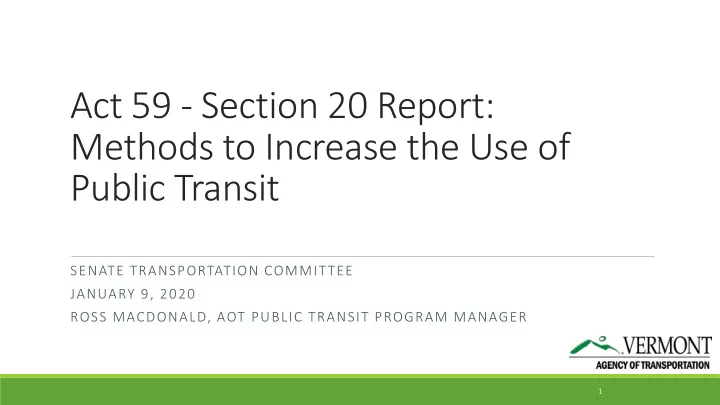

Act 59 - Section 20 Report: Methods to Increase the Use of Public Transit SENATE TRANSPORTATION COMMITTEE JANUARY 9, 2020 ROSS MACDONALD, AOT PUBLIC TRANSIT PROGRAM MANAGER 1
Presentation Overview Legislative Language Study Methodology Major Findings Study Recommendations Questions and Discussion 2
Act 59, Section 20 “The Agency of Transportation shall, in consultation with stakeholders, study methods to increase use of public transit in Vermont for both residents and visitors. This study shall review the Agency’s current initiatives and those in other territories, states, and countries; review literature, marketing, and activities regarding methods to increase ridership with special emphasis on rural areas; determine unmet needs from current studies; examine the benefit of providing local connectivity to transit; and evaluate what factors affect public transit ridership in Vermont.” 3
Act 59, Section 20 cont. “The Agency shall deliver a written report of its findings and recommendations including where and how to make the most effective improvements in service and criteria to use to determine the priorities of investments” “The Agency shall evaluate recommendations for potential inclusion in its fiscal year 2021 budget proposal and estimated funding necessary to achieve the recommendations for any new initiatives identified in the study” 4
Study Methodology Literature Review – National Cooperative Highway and Transit Research Reports, Trade Journals, University Transportation Research Centers Analysis of Vermont Transit Services – characteristics of the most / least successful services Stakeholder Input – two meetings and draft report review Public Transit Policy Plan alignment – Goals, Target Markets for Increased Ridership, Strategy Development 5
Major Findings – literature review • Strengthening community awareness and marketing transit service remains a critical part of attracting new riders. • Successful rural transit agencies actively manage their services. • “Old tricks” like regional connecting services, university pass programs, and free ride days are still important strategies. • “New” ideas and technologies are creating opportunities to grow rural transit ridership. • Partnerships are an essential part of successful rural transit services. • Strategies are often synergistic: transit agencies can maximize efforts to increase ridership by coordinating these efforts. • State support is essential. 6
Major Findings – Vermont route analysis HIGH RIDERSHIP ROUTES High productivity is often a function of limited or targeted service ◦ Only the best transit corridors have high productivity with a high level of service High ridership related to several factors ◦ Major trip generators ◦ Dense and continuous development ◦ Frequent and direct (time-competitive) service In Vermont, ski areas and universities are keys to transit success ◦ Low/free fares and rider subsidies also important factors 7
Major Findings – Vermont route analysis LOW RIDERSHIP ROUTES Small towns and villages may have mobility needs but still not generate enough demand to support a traditional bus route ◦ Low service levels not attractive to residents who can drive ◦ Pedestrian facilities poor or nonexistent in many non-urban areas Commuter routes face uphill battle in era of low gasoline prices Confusing/poorly designed schedules can be a barrier Capital investment also critical to attract choice riders, but hard to justify in low-density areas ◦ Shelters and lighting ◦ Cutaways can be a disincentive 8
Major Findings – PTPP Goals POLICY GOALS SUPPORTING INCREASED TRANSIT RIDERSHIP Make the most of existing investment Address unmet needs for mobility Reduce energy use and GHGs Reduce traffic congestion and wasted time Free up resources used on automobiles 9
Major Findings – Needs Analysis TARGET MARKETS People with unmet transportation needs ◦ Older adults (especially over 80) ◦ People with disabilities ◦ Low-income individuals ◦ Youth (mostly age 13-18) People with transportation options but open to using transit ◦ Millennials ◦ Generation Z ◦ Urban dwellers ◦ Eco-minded people from any generation 10
Target Markets SERVING PEOPLE WITH UNMET ATTRACTING PEOPLE WITH TRANSPORTATION NEEDS TRANSPORTATION OPTIONS Provide more convenient and available Improve the convenience of transit relative to demand-response service driving Operate evening/weekend service for job Enhance comfort and image of transit access and other purposes Improve pedestrian and bicycle access to bus Employ mobility managers for training and stops coordination Make information more readily available 11
Short-Term Strategies (1-3 years) Action Cost Ridership Impact Ease of Implementation Local access connections Low (variable) Low Moderate Expand partnerships Low Low Easy Pursue marketing Moderate Low to moderate Easy campaign Moderate, Low in rural areas, Easy for rural areas, Fare Free policy high for GMT high for GMT moderate for GMT Invest in technology Moderate Low to moderate Moderate Low in urban area, Paradigm shift for demand Moderate moderate in rural Moderate to difficult response areas Capital investments High Low to moderate Moderate Service increases High Moderate Moderate 12
Long-Term Strategies (years to decades) Implement “Complete Streets” and other bicyclist and pedestrian- friendly improvements Active management and planning of transit services Better coordination of land-use and transit planning 13
Questions? ROSS MACDONALD/ PUBLIC TRANSIT PROGRAM MANAGER ROSS.MACDONALD@VERMONT.GOV 14
Recommend
More recommend